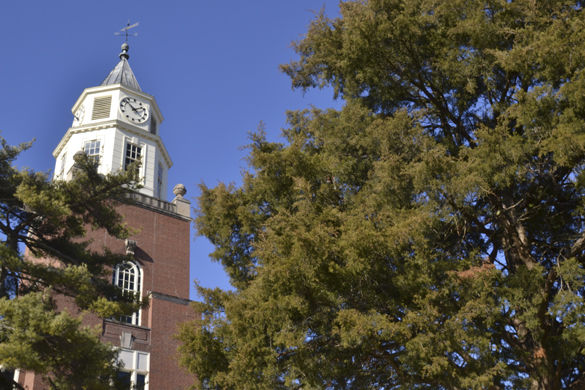SIU enrollment at lowest point since 1965, data shows

Daily Egyptian file photo
September 7, 2016
Fall enrollment at SIUC in 2016 is at its lowest point in more than half a century, according to data released by university officials Tuesday.
Fewer than 16,000 students are currently enrolled in undergraduate and graduate programs this year, according to the university’s 10-day enrollment figures. That marks a 7.6 percent decrease from the previous year, as campus enrollment continues its steady downward trend that has, at best, stagnated or seen slight increases over the past 20 years.
The last time the university had fewer students enrolled was in 1964.
Advertisement
Interim Chancellor Brad Colwell said during a press conference Tuesday the figures are disappointing, but expected.
“We knew it was coming,” he said. “It’s not a surprise to us.”
The largest reduction was with the freshman class, which has 660 fewer students than last year. Students in graduate master’s programs fell by 328 students, a decline of 13.2 percent, and doctoral programs had 106 fewer students, a loss of 9.7 percent.
Meanwhile, junior and senior classes both grew by 3.7 percent with 103 and 168 additional students, respectively. Colwell said those numbers show the university’s retention efforts have been effective.
Overall, there are 15,987 students enrolled, a drop of 1,305 from 2015.
Colwell attributed the decline to a number of factors, including the state’s budget crisis and reduced availability of assistantships for graduate students. The overall drop translates to a loss of roughly $6.5 million in tuition dollars, which was factored into the university’s campus-wide cuts of $21 million earlier this year, Colwell said.
“As far as tuition dollars, this is absolutely not a surprise to us and has been adjusted accordingly,” he said.
Advertisement*
Colwell said it is “too early to tell” if there will be further cuts to staff or programs down the road because of uncertainty with the state budget in fiscal year 2017, but the measures taken through layoffs, unfilled positions and cuts to programs have prepared the university administration for the current loss of tuition revenue.
Part of the problem reflected in the freshman enrollment statistics has to do with an exodus of students from the region to institutions in neighboring states, said Rae Goldsmith, a spokeswoman for the university.
“We know that we are losing not only instate Illinois students going out of state, but we’re losing out of state students who would have come to Illinois,” Goldsmith said.
Southeast Missouri State University reported an increase of nearly 50 percent of Illinois students compared to last year. At the same time, Murray State University is reporting a 40 percent increase of Illinois students.
The numbers at SIU are in line with some of the warning calls university administrators issued last year in light of proposed cuts and a lack of state support for public higher education. But other public state universities seem to have fared well despite the state’s financial problems. Illinois State University and University of Illinois have both reported record-high freshman enrollments this year.
Colwell said administrators are working to implement new strategies with hopes of growing the freshman class by 10 percent in 2017.
Terri Harfst, the university’s newly appointed interim director of undergraduate admissions, said one of the university’s new strategies was to make admission decisions a few months earlier compared to last year. She added the university has since received more than 1,000 applications and admitted 400 students to the university for Fall 2017.
“We are increasing the number of prospective students that we’re reaching out to,” Harfst said. “We are expanding our high school visits and we’re analyzing our communication flow.”
As eyes turn toward next year’s enrollment, Colwell said he is asking the college deans to take a “hard look” at programs with input from the university’s academic prioritization committee to make sure to programs the university is offering are “the right ones.”
He added the university may have to re-examine its current model of being “all things to all people” and may in the near future reduce the majors offered to students.
“We need to ensure that we are using our resources wisely, and doing so in the best interest of our students,” he said.
Campus editor Bill Lukitsch can be reached at blukitsch@dailyegyptian.com or on Twitter @lukitsbill.
To stay up to date with all your SIU news, follow the Daily Egyptian on Facebook and Twitter.
Advertisement










Andrew • Sep 8, 2016 at 6:36 pm
SIU has a tradition of educating the children of the working class. That’s what I was — dad was a truck driver, mom was a nurse. Nothing to be ashamed of. But the working class has been under siege for some time now financially. Combined with the ridiculous escalating cost of higher ed, SIU’s market has disappeared. I’m class of 83 and what’s happened to siu breaks my heart. Still recommend it but siu is not getting the government/taxpayer support it needs.
VapeNation • Sep 7, 2016 at 6:38 pm
There aren’t enough people vaping on campus.
Perry Akins • Sep 7, 2016 at 4:23 pm
I graduated from SIU with a BA in 1963 and an MS in 1965. This article in the Egyptian was very disheartening. What was most disappointing was the fact that the University administration does not seem to be accepting much responsibility. The enrollment decline is not a new problem. Administration after administration has been kicking this can down the road in hopes of a miracle. A miracle is certainly needed since the administration has so far proven incompetent to deal with this issue. SIU has so much to offer and it is truly regrettable that a Delyte Morris (former president) has not come along to lead the University into growth and prosperity.
Bobbie • Sep 7, 2016 at 12:57 pm
Not surprising at all considering the crime that has happened lately in addition to the tuition rate being so high. Also, my experience was that the University as a whole was disorganized. Classes being changed from one room to another and books being changed last minute. The education advisors even seemed like they didn’t know what they were doing. Why would a person choose to go to a college that is disorganized in a city that has high rates of crime lately? Let alone why would a parent see that as a safe environment for their children to go to college? Especially when there are other colleges with a better quality of education, possibly less tuition rate in a less crime invested city elsewhere. Students want to feel safe and parents want to feel as if their children are going to be safe when they go off to college. Hopefully, they also want to get a good quality of education as well and collaborate with staff who they feel like know what they are doing.